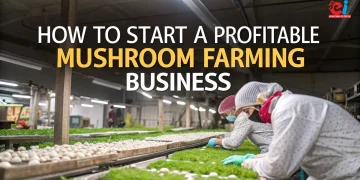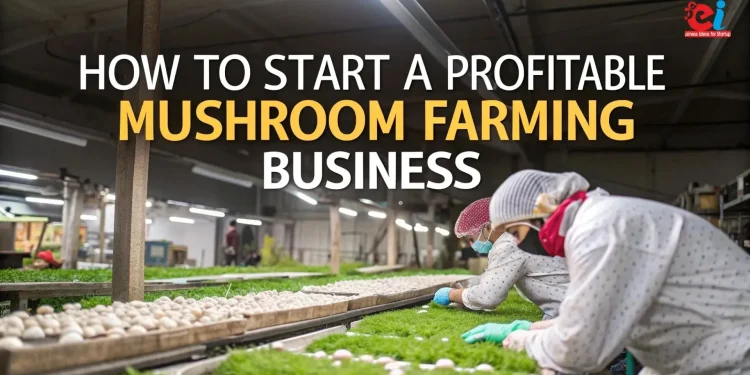Mushroom Farming is one of the fastest-growing forms of agribusiness due to its scalability. With the increase in awareness around plant-based diets, medicinal mushrooms, and sustainable agricultural practices, mushroom farming is no longer a rural hobby. It is a commercialized business that is attracting massive investments from startups, elders, agritech investors, and entrepreneurs who are looking to invest in a low-land-use, high-margin agriculture.
India has an abundant supply of agricultural waste that can be used as a substrate, and there is also a growing domestic as well as international market for mushrooms. There are many varieties of mushrooms that can be farmed such as button mushrooms, oyster mushrooms, shiitake mushrooms, and even medicinal mushrooms like Ganoderma. Whether you start with a low investment or fully automated temperature-controlled units, having a strategic link to the market is vital.
In this guide, we provide you with the essential knowledge required for starting a mushroom farming business. We walk you through choosing the right variety of mushroom, planning the infrastructure, understanding production cycles, estimating profit margins, and how NPCS can assist you in building a successful mushroom farming business.
Summary of the Market Potential and Opportunities Available for Investment in Mushroom Farming
There are may reasons for Indian consumers to increase their consumption of mushroom, like its nutritional value, increases immunity, and use in drug manufacturing and processed foods. Taking into account industry reports, the Indian market for mushrooms is likely to see at least 8% growth rate per annum from 2023 to 2028, with mushrooms cultured as buttons being the most common, followed by oysters and medicinal mushrooms.
Fresh and dried mushrooms have increased demand owing to the fact that urban residents are inclined towards high-protein, low-fat diets. There is increased demand for Indian mushrooms in the USA and other parts of Europe and South-Asian countries, especially dried oyster mushrooms and Reishi mushrooms, which has led to a surge in their export potential. Entrepreneurs now have the opportunity to invest in mushroom farming by integrating scalable hygienic structures to meet market demands.
NIIR Project Consultancy Services provides a detailed analysis of the trends prevailing in the market with the help of project reports and feasibility studies which allows for investment estimation and forms the baseline for mitigation strategies to ensure reduced risks and increased returns.
Related: The Boom of Medicinal Mushrooms: Profitable Start-ups in Herbal Medicine
How To Choose The Best Type Of Mushroom To Cultivate
In India, wide-scale cultivation caters to the following mushrooms:
- Agaricus bisporus (Button Mushrooms): The mushroom type that has the highest consumption. It is cultivated in cooler regions (16-18 degrees Celsius) with the help of compost beds and controlled environmental conditions.
- Mushrooms of Pleurotus species (Oyster Mushrooms): These mushrooms thrive in tropical and some subtropical areas, achieving substantial growth in just 25 to 30 days. Being cost-effective and requiring the use of agricultural waste helps these mushrooms stand out.
- Calocybe indica (Milky Mushrooms): Require conditions that provide heat and humidity, making it the best option for regions with temperatures above 25 degrees Celsius.
- Ganoderma (Reishi), Shiitake: Relatively poorer known than the others but with unmatched international demand due to their medicinal properties. Unlike the others, they require a high crop cycle, making them a better long-term investment.
NPCS is suitable in that regard with detailed reports on cost, yield and price, based on local climate and resources.
Setting Up Infrastructure and Farms for Mushroom Growing
Unlike traditional field-based agriculture, mushroom farming requires a high productivity, space-efficient farming system to be indoors and fully controlled for hygiene. A commercial mushroom farm can be started in as little as 500 sq ft and scaled further to larger operations with multi-tiered growing racks, and air-conditioned grow rooms.
- For oyster mushrooms, basic infrastructure includes thatched shed, racks, humidity control (sprinklers or foggers), and plastic bags for substratum bulk packing.
- For button or shiitake mushrooms, a more advanced facility is required that has temperature control (cooling units), air circulation, and compost preparation units.
NPCS provides technical guidance and architectural layout plans for mushroom farms tailored to local climate conditions, production scale, and available capital. A medium scale unit growing 500–1000 kg per cycle would require space for spawn preparation (or spawn procurement), substrate sterilization, incubation, cropping, and post-harvest handling.
Preparation of Substrates for Cultivating Mushrooms
The most relevant part of the mushroom cultivation is in the mycelial development. This requires the nutritive substrate. Depending on the mushroom variety, the substrate usually contains paddy straw, wheat straw, sugarcane bagasse, sawdust, cotton waste or other composted materials. It is sliced into smaller pieces, soaked, pasteurized or sterilized, and then inoculated with the mushroom spawn.
Certified labs can sell spawn (mushroom seed) to be purchased or one of the entrepreneurs can prepare in-house with the required expertise. After mounting the spawn in the substrate, it is placed in incubation chambers. The environment inside these chambers are maintained with specific temperature, humidity (80–90%) CO₂ levels, and light intensity.
Depending on the species, mushroom fruiting starts within a range of 15–30 days. The harvest period is for roughly 7–15 days with some day-to-day or every other day picking. Each bag or tray gives approximately 1.5–2 crops per cycle. After removing the entire batch, the entire area is cleaned, and with the help of fresh substrate the next cycle is prepared.
NPCS in their detailed mushroom farming project reports provides each process flow diagram, SOPs of each process, customized substrate formulae, and contact spawn source.
Related: Organic Farming and Compost Production: A Profitable Industry Business
Post-Harvest Handling, Packaging, and Value Addition
Mushrooms are so perishable that they require the utmost post-harvest care. A post-harvest process involves cleaning, grading, and storing the mushrooms in a cold environment below 10°C. For local markets, mushrooms are packed in perforated punnets or polythene bags and sold within 24 to 48 hours.
Industry experts suggest waiting too long before investing in value addition through drying, pickling, powdering, or canning. Dried mushrooms, especially of the oyster and reishi varieties, have gained huge popularity over the past few years within health food stores and even among international buyers. Not to mention, mushroom powder has created a demand in the production of soup, seasoning mixes, nutraceuticals, and even functional foods.
Approaches towards modern-day marketing have made it a necessity. In this particular field, nutrition, along with the farm freshness and cleanliness, should be etched in the minds of buyers. Claiming to offer sustainably cultivated produce that enables traceability would further boost easy marketing.
If you want to reach customers while your product is in pristine condition, NIIR Project Consultancy Services suggests amending storage protocols, label design standards, and provides them with your packaging machine specifications.
Marketing and Sales Strategy for Mushroom Farmers
Payments received prior to delivery enable a business-to-consumer and business-to-business approach. What makes mushroom farming unique is that it allows access to both B2B and B2C markets.
B2B Options:
- Bulk supplying to supermarket chains
- Cuisine chain hotels
- Food processing companies
- Exporters
- Suppliers for restaurants
B2C Options:
- Selling directly to local consumers
- Weekly farmers markets
- Organic stores
- Subscription bases
An increasing count of entrepreneurs are labeling their mushrooms organic, under medicinal categories, or as farm-fresh to appeal to city-dwelling consumers concerned about their health. You may also consider collaborating with e-commerce aggregators and farm-to-fork distribution services that specialize in delivering fresh produce.
From an international trading view, mushrooms that have been dried and powdered represent considerable potential in markets such as wellness, vegan, and herbal medicine. The USA, Germany, and Japan are significant consumers of dehydrated or powdered reishi and oyster mushrooms.
NPCS has mushroom farming consultancy packages which include templates of marketing plans, pricing policies, contacts of distributors, and even offer assistance in compiling export documents.
Mushroom Farming Profitability and Cost Analysis
Tracking mushroom farming benefits, one stands out from the rest, it’s ROI which can be achieved in a very short time frame. A simple farm unit with the capacity of producing 500 kg of oyster mushroom per month can earn revenue between ₹80,000 to ₹1,00,000 every month while net earnings are around 25 to 30 percent. When compared to other types of mushroom farming like the button mushrooms which have high infrastructure costs, their profits tend to be made after a constant yield and market linkage performance.
Starting a new small farm unit requires you to have somewhere between ₹3 to 5 lakhs set aside for shed building, purchasing spawn, buying tools and rack along with working capital. For earning the button mushrooms, which have higher earning potential, a medium scale unit is recommended with an upper limit of ₹10 to 20 lakhs and a 5 ton monthly capacity. In both scenarios a 1 year break-even period is achievable depending on how efficiently the farming is done alongside the efficiency of the sales and marketing team.
Complete breakdown of the costs and ROI alongside the cash flow statement, breakeven graphs are available in NPCS project reports, along with document detailing the funding available through MSME and Agri Infra schemes.
Reasons to Work with NIIR Project Consultancy Services (NPCS) for Executing Your Mushroom Farming Project
A mushroom farming business requires more than just passion. It requires strategic planning, a thorough understanding of the technology involved, and proper market management. Here is why NIIR Project Consultancy Services (NPCS) stands out. NPCS has helped clients for decades in customizing detailed project reports and providing industrial project reports, NPCS aids in:
- SOPs detailing all exclusive project activities including oyster, button, shiitake, and even and medicinal mushroom farming.
- Complete Technical Layouts for spawn units and incubation rooms as well as packaging zones.
- Guidance on Machinery and Substrate Setup considering project scope and budget.
- Financial Modeling help with other government aids like NABARD grant subsidies and MSME loans.
- Advisory support for marketing, branding, and exports.
NPCS has ‘sow-start’ programs designed to help first-generation entrepreneurs become business owners. Whether you identify yourself as an agribusiness professional or a potato startup looking to enter into ‘agritech’ deep-tech farming solutions, NPCS arms you mushroom farming as a venture that’s not simply viable, but highly scalable and profitability.
Final Thoughts: Advancing Change with Mushrooms
With health, sustainability, and nutrition at the forefront of consumer preferences, mushroom farming has emerged as a post-pandemic entrepreneurial opportunity that is unique. It takes up little space, requires minimum water for irrigation, and offers high profits in a matter of weeks. This business has untapped potential and is extremely diverse as it offers everything from fresh mushrooms for culinary use to functional mushrooms for the pharmaceutical industry.
Modernized growing methods and professional project planning give incentive to entrepreneurs to scale faster and occupy more lucrative markets. The demand is increasing, the profit margins appear quite promising, and with guidance from NIIR Project Consultancy Services (NPCS), within no time you can be termed a mushroompreneur.
So, start today and transform your innovations into a sustainable and thriving enterprise.


























